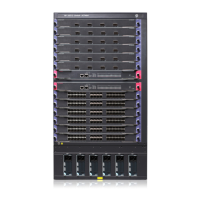351
Configuring a tunneling policy for a VPN instance
When multiple tunnels exist in an MPLS L3VPN network, you can configure a tunneling policy to specify
the type and number of tunnels to be used by using the tunnel select-seq command or the preferred-path
command.
With the tunnel select-seq command, you can specify the tunnel selection preference order and the
number of tunnels for load balancing.
With the preferred-path command, you can configure preferred tunnels that each correspond to a tunnel
interface.
After a tunneling policy is applied on a PE, the PE selects tunnels in this order:
• The PE matches the peer PE address against the destination addresses of preferred tunnels, starting
from the tunnel with the smallest number. If no match is found, the local PE selects tunnels as
configured by the tunnel select-seq command or the default tunneling policy if the tunnel select-seq
command is not configured. The default tunneling policy selects only one tunnel (no load balancing)
in this order: LSP tunnel, CR-LSP tunnel.
• If a matching tunnel is found and the tunnel is available, the local PE stops matching other tunnels
and forwards the traffic to the specified tunnel interface.
• If the matching tunnel is unavailable (for example, the tunnel is down or the tunnel's ACL does not
permit the traffic) and is not specified with the disable-fallback keyword, the local PE continues to
match other tunnels. If the tunnel is specified with the disable-fallback keyword, the local PE stops
matching and tunnel selection fails.
IMPORTANT:
Create a tunneling policy before associating it with a VPN instance. Otherwise, the default tunneling
policy is used. The default tunneling policy selects only one tunnel in this order: LSP tunnel, CR-LSP tunnel.
To configure a tunneling policy for a VPN instance:
Ste
Command
Remarks
1. Enter system view.
system-view N/A
2. Create a tunneling
policy and enter
tunneling policy view.
tunnel-policy tunnel-policy-name
N/A
3. Configure a preferred
tunnel and specify a
tunnel interface for it.
preferred-path number interface
tunnel tunnel-number
[ disable-fallback ]
Optional.
By default, no preferred tunnel is
configured.
NOTE:
• In a tunneling policy, you can configure
up to 64 preferred tunnels.
• The tunnel interfaces specified for the
preferred tunnels can have the same
destination address and the tunnel
encapsulation type must be MPLS TE.

